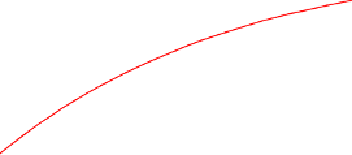Environmental Engineering Reference
In-Depth Information
The values of
I
r
, I
n
, and NBI were further calculated for both networks increasing the pipe
diameters gradually and uniformly, for 2 %; fourteen simulation runs have been conducted
applying the same increments and the results showing the change of three indices for the
net10
and
net16
, for total diameter increase of 32 %, are given in Figures 5.14 and 5.15.
1
0.9
0.8
0.7
Ir
In
NBI
ADFavg
ADFmin
0.6
0.5
0.4
0.3
0.2
0.1
0
1
2
3
4
5
6
7
8
9
10
11
12
13
14
15
Figure 5.14
Comparison of I
r
, I
n
and NBI for increased diameters of net10
1
0.9
0.8
0.7
Ir
In
NBI
ADFavg
ADFmin
0.6
0.5
0.4
0.3
0.2
0.1
0
1
2
3
4
5
6
7
8
9
10
11
12
13
14
15
Figure 5.15
Comparison of I
r
, I
n
and NBI for increased diameters of net16
Another series of simulation runs was done in the same way for the single increase of the
demand multiplier of 2 % (total 32 %) and those results are shown in Figures 5.16 and 5.17.
Finally, Figures 5.18 and 5.19 show the effect of 2 % increase of PDD threshold pressure. In
all the figures, the corresponding average network values of ADF are plot together with
ADF
min
, which is the value after the worst-case pipe failure.
There are four major observations looking at the results in Figures 5.14 to 5.19:
1.
All three indices follow the same trend. Nevertheless, the correlation of NBI to the values
of ADF is better. This is not a surprise knowing that the ADF is the input parameter for
calculation of NBI.
2.
All three indices show negative value if the level of service is (significantly) disturbed
during regular supply i.e. at no-failure conditions; this can occur in case of insufficient














































































































































































































































Search WWH ::

Custom Search